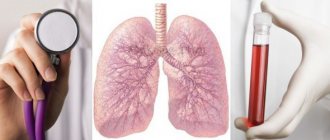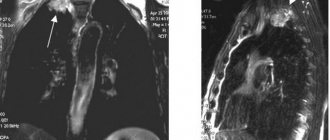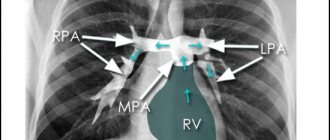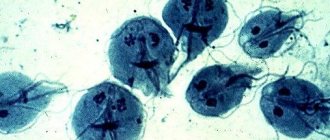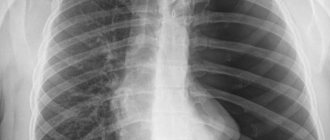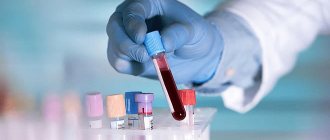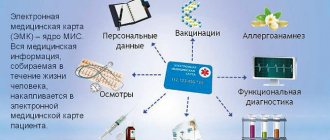In medicine, tumor markers are commonly referred to as enzymes produced by malignant tumors. Tumor markers are formed by tumors and penetrate into the human body, where they are detected through laboratory diagnostic techniques. The determination of tumor markers in a patient’s biomaterial indicates the presence of an oncological disease. This option for detecting pathology is one of the most popular and effective, so we will further learn what tumor markers for lung cancer are.
Tests for tumor markers: when is it indicated to undergo examination?
Tumor markers for lung cancer are detected in the presence of the following symptoms:
- Symptoms of cough, when manifested, there are signs of sputum with blood particles.
- Loss of weight and appetite for no apparent reason.
- An increase in body temperature, accompanied by the absence of various diseases.
- Decreased performance.
A cancer test can also be prescribed not only to determine the presence of pathology, but also to monitor the results of treatment. The rationality of therapeutic treatment is visible only by comparing the initial results with the final ones.
What are tumor markers, indications for testing tumor markers for lung cancer?
These specific substances begin to be intensively produced by the body during the development of tumor processes of various types, both malignant and benign. A test for tumor markers can often detect the onset of lung cancer even before the first symptoms appear. Testing for tumor antigens is a common test of blood or other biological fluid, but it is not always prescribed. The decision about the need for this test is made by the attending physician based on many indicators. First of all, a blood test for tumor markers of lung cancer is prescribed to patients with a history of chronic pathologies of the respiratory system. For this category of people, tests for the presence of specific markers in the blood serum are carried out as part of screening diagnostics performed every 6 months.
What tumor marker shows lung and bronchial cancer?
In addition, this study is prescribed if a person suddenly develops alarming symptoms: a persistent cough with the release of blood-stained sputum, fever without an infectious cause, sudden and causeless weight loss. Tumor markers are also taken after a confirmed diagnosis of lung cancer.
In this case, marker research can be prescribed for several purposes:
- to monitor ongoing antitumor therapy;
- to determine the effectiveness of the operation;
- for timely detection of distant metastases;
- to identify the degree of likelihood of relapse of the oncological process.
Worth knowing! Timely detected increases in lung tumor markers in most cases contribute to the early detection of cancer, which increases the patient’s chances of a full recovery. It must be remembered that only an experienced specialist who is familiar with all the nuances of changes in the indicators of these specific proteins should prescribe such an analysis and interpret its results.
Types of tumor markers: what are they?
Cancerous or mutating cells are formed through various abnormalities that are formed during the division or differentiation of healthy cells. The process of the appearance of cancer cells is called atypism, and cancer cells are called atypical. Cancer cells differ from normal cells in structure and metabolism.
During metabolism, many compounds are formed inside or on the surface of cancer cells that contribute to tumor formation. A tumor marker for lung cancer can be not only a consequence of neoplasms, but also a normal consequence of human life. Ideal tumor markers include compounds that are characterized by:
- Availability of 100% specificity of belonging to oncopathology.
- Possibility of detection in the early stages of pathology.
- High rate of decay, through which it is possible to determine the effectiveness of conservative treatment methods.
- Tumor heterogeneity. Indicates the presence of cells of varying degrees of maturity in the tumor.
Oncological markers are often determined through a blood test, and less often using urine, exudate and biopsy. The following substances act as tumor markers of carcinoma:
- hormones;
- enzymes;
- plasma proteins;
- antigens and antibodies.
It is important to know! Until now, not a single ideal tumor marker has been established that would allow one to judge with 100% confidence the development of an oncological disease. However, over many years of clinical practice, about 20 compounds have been identified that have a fairly high diagnostic value.
Accuracy of the study
The results that specialists obtain during laboratory testing cannot be used as absolute criteria for making a final diagnosis of cancer.
Often, excess tumor markers can be observed with the development of benign tumors.
To clarify the diagnosis, a repeat test is necessary. As a rule, the procedure is carried out a month after the last diagnostic event. If this time the values exceed normal values, then a comprehensive examination is prescribed, the main task of which is to assess the condition of the internal organs to which a specific reaction of tumor markers was noted.
In the absence of results that would indicate a malignant process, a repeat blood test is carried out six months later.
How to identify tumor markers
Lung cancer, depending on its morphology, clinical course and sensitivity to radiation and chemotherapy, is divided into the following types:
- Small cell . This type is also called small cell carcinoma.
- Non-small cell , which includes: adenocarcinoma, squamous cell carcinoma, and large cell carcinoma.
- Mixed or histological type.
The main values for identifying the histological type of lung cancer are considered to be:
- For small cell cancer: NSE and ProGRP;
- Adenocarcinoma or large cell carcinoma: CYFRA 21.1, CEA.
- Squamous cell carcinoma: SCCA, CYFRA 21.1 and CEA.
- Unidentified histological type: CEA, CYFRA 21.1, NSE and ProGRP.
Detection of the level of the above indicators for oncology is carried out using an enzyme-linked immunosorbent test for lung cancer. Let us identify the features of these indicators in more detail.
- Tumor marker NSE . When the value of the NSE tumor marker in the blood is over 100 μg/l, we should talk about the development of small cell lung carcinoma. This marker is used to detect small cell carcinoma, as well as diagnose other types of cancer: liver cancer, lymphoma, non-small cell lung cancer.
- ProGRP . Specific indicator of non-small cell carcinoma. Due to the high sensitivity of this indicator, it is used to diagnose lung cancer in the early stages. The great significance of lung cancer is revealed by a high level of ProGRP value, which exceeds the value of 200 ng/L. If the value of this indicator reaches 300 ng/l, then there is a high probability of developing small cell carcinoma. The development of small cell cancer can be judged when the marker concentration exceeds 500 ng/l.
- CYFRA 21.1 and SCCA . Diagnosis of oncology involves the use of a tumor marker called CYFRA 21.1. Its main advantage is high sensitivity in the development of non-small cell types of oncopathologies. Compared to CYFRA 21.1, the SCCA tumor marker is less sensitive. However, for diagnosing squamous cell carcinoma, the significance of the SCCA indicator is much higher, since already with a value of over 2 μg/l one can judge the presence of cancer of this type.
- CEA antigen . An increase in the CEA antigen in the blood occurs with the development of adenocarcinoma and large cell cancer. If the CEA antigen value exceeds 10 μg/l, then there is a high probability of developing adenocarcinoma or large cell carcinoma.
A number of additional tumor markers for diagnosing pathology include:
- CA125.
- TPA.
- TPS.
- TU-M2 PK.
It is important to know! Statistics show that even negative test values cannot guarantee the absence of cancer. In this case, it is important to resort to a comprehensive examination of the patient’s body.
A number of additional techniques for detecting squamous cell lung cancer include: x-ray, biopsy or bronchoscopy.
Preparation
In order for the result obtained during the analysis to be as accurate as possible, patients need to complete several preparatory measures.
The collection of blood fluid to determine tumor markers should be carried out exclusively in the morning and on an empty stomach. It is important to remember that it is necessary to eat before this no later than 12 hours before the procedure. Liquid consumption in the form of purified water is allowed. You cannot drink coffee, tea or juices.
About a week before the scheduled date of taking the test for tumor markers, it is mandatory to give up alcoholic beverages. The patient should not smoke 60 minutes before the laboratory procedure.
In addition, to obtain the most reliable results, experts recommend normalizing your emotional state.
On this topic
- Oncopulmonology
Lung cancer on CT
- Olga Vladimirovna Khazova
- December 5, 2020
Experts also do not recommend undergoing the procedure immediately after visiting a sauna, physiotherapeutic procedures, massage or X-ray examination.
If the patient has a history of cancer treatment, the test can be repeated no earlier than 90 days after the end of therapy.
General blood analysis
A general analysis involves extracting blood from a finger - a capillary. If oncological processes are observed in the lungs, then the study parameters will have certain deviations. The erythrocyte sedimentation rate increases significantly: the higher this parameter, the more complex and dangerous the disease. For example, if the ESR is about 30-50 mm/h, then this is a consequence of the intensive progression of cancer.
It is also worth considering the level of hemoglobin - for oncologists it is a kind of indicator of tumor growth. With indicators of 60-70 units. the doctor can draw a conclusion about what complications may occur in the near future.
In addition, based on the content of leukocytes, the presence of a disease is established - if there is a deviation from the norm to a greater extent, we can talk about inflammatory processes in the body - an indispensable attribute of oncology. But it is worth remembering that you need to avoid eating fatty and heavy foods before the study, as such food helps to increase the level of leukocytes.
A general blood test can be called one of the easiest, but at the same time informative diagnostic methods. But using this procedure alone, it is impossible to accurately determine the presence of a tumor in the lungs, since the corresponding changes may cause other abnormalities in the body. Therefore, if violations are detected, it is subsequently worthwhile to undergo a full examination.
How to detect pathology using blood?
A laboratory blood test shows the level of erythrocyte and leukocyte cells, hemoglobin content, sedimentation rate, etc.
When conducting biochemical and tumor marker analysis, specialists receive more accurate and informative data regarding the patient’s condition.
Some patients are especially advised to undergo blood tests for preventive purposes.
The group of such patients includes:
- Smokers;
- People with a hereditary predisposition to lung cancer;
- Those who are employed in hazardous industries, work with heavy metals or toxic chemical compounds;
- Those suffering from chronic respiratory pathologies such as obstruction or pneumosclerosis, etc.;
- Those in contact with radon;
- Those living in environmentally unfavorable areas, large cities with air polluted by exhaust gases, etc.
Causes and signs of the disease
The risk of developing the disease increases under certain work conditions, such as exposure to asbestos, uranium, chromium, arsenic, and a variety of other toxic substances.
Lung cancer can begin to develop due to increased atmospheric pollution, for example, excessive amounts of exhaust gases from cars, stations and factories heavily pollute the air. In the first stages, cancer is not noticeable to a person, without any manifestations. Further symptoms may appear such as:
- shortness of breath and hoarseness;
- regular cough;
- general weakness of the body.
In subsequent stages, the patient will feel pain in the chest area, with deep entry the pain intensifies. The fingertips become thicker. A very alarming sign can be sudden weight loss, constant colds, pneumonia and bronchitis. In the last stages it begins to bother:
- pain in bones, joints;
- some parts of the face are paralyzed;
- the voice changes to more hoarse;
- there are difficulties when swallowing.
If all of the above symptoms occur, you should go to the hospital.
How does the cancer process begin in lung tissue?
The primary symptoms of lung cancer are important, because their timely detection prompts the patient to visit a specialist and helps to diagnose oncological processes in the early stages of their development.
The following manifestations indicate the onset of pulmonary oncology:
- Frequent and causeless, difficult to treat pulmonary inflammation and bronchitis;
- Frequent shortness of breath, first after physical exertion, and then at rest;
- Cough, initially dry, and then accompanied by sputum production. Coughing attacks occur suddenly and are rarely disturbing, but with further progression of the oncological process they occur more often, accompanied by the release of sputum with bloody streaks;
- Chest pain;
- Persistent and causeless hyperthermia of a subfebrile nature (37.5-38°C);
- Angina disorders;
- Depressive state associated with chronic fatigue.
Interpretation of results
After all research data has been received, they are entered into a table where information on each specific parameter is displayed. The adjacent column shows the normal values. If there are deviations in any indicator, this is a signal of a possible pathology.
Based on the data, the doctor makes a conclusion about the need for additional hardware research. In some cases, differential diagnosis is used if there is a suspicion of liver and kidney pathologies that are not associated with lung cancer.
For lung cancer, the transcript contains the following information:
- Low levels of red blood cells and hemoglobin, progressive anemia.
- Exorbitant concentration of leukocytes and a sharp, spasmodic decrease over the next days.
- Increased ESR to critical values (over 50 mm per hour).
- Violation of the concentration of protein fractions: insufficiency of albumin and excess of globulins.
- High levels of calcium ions.
- Excessively high levels of urea, creatinine, cortisol.
As for tumor markers, in the presence of lung cancer they manifest themselves in the following indicators:
- TPA – more than 75 units, indicates a high degree of malignancy of the tumor process.
- CEA – 5.5 ng/ml for smokers and 3.8 ng/ml for non-smokers indicates a pronounced oncological process in the lungs.
- NCE – more than 15 ng/ml of blood.
- CYFRA – more than 10 ng/ml.
In a healthy person, in whose body there is no cancer, all tumor markers are equal to zero or tend to this indicator. The appearance of insignificant quantitative indicators of markers may be associated with the presence in the body of pathological processes of the liver and kidneys that are not related to oncology.
